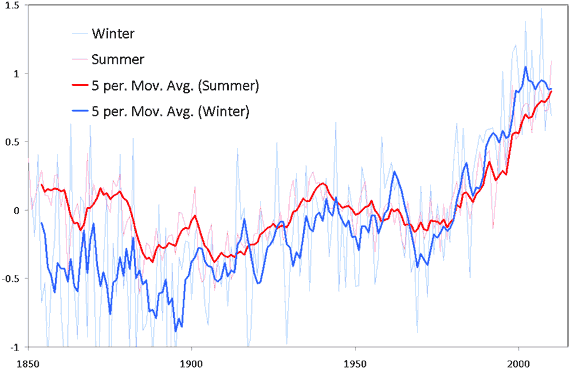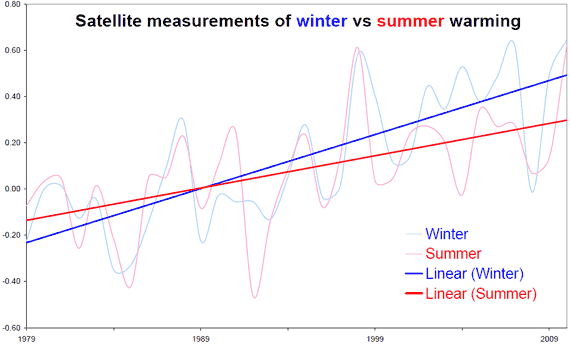The human fingerprint in the seasons
Posted on 3 December 2010 by John Cook
In 1896, Svante Arrhenius mentioned that greenhouse warming should cause winters to warm faster than summers (Arrhenius 1896), citing an earlier prediction by John Tyndall (Tyndall 1865). During summer, a region receives more sunlight and warms. During winter, the region receives less sunlight and cools by radiating heat to space. Greenhouse gases stop some of this heat from escaping to space so an increased greenhouse effect slows down the winter cooling. Consequently, if greenhouse gases are causing global warming, we expect to see winters warming faster than summer.
A pair of studies (Braganza et al 2003, Braganza et al 2004) recognise that within the temperature record are a number of climate indices that can tell us more about what's causing temperature change than mere global temperature. The difference in trend between summer and winter, between land and ocean warming, between the equator and the poles - these all hold vital clues into what has caused climate change since the instrumental record began in the 1800s.
They found that winters have been warming faster than summers. What's interesting is how the seasons have changed over time. In the early 20th century, they find the warming is a combination of man-made and natural forcing (eg - from the sun) as well as some internal variability (eg - ocean cycles). In the latter 20th century, man-made forcing accounts for nearly all the observed temperature changes (Braganza et al 2004).
To check this out for myself, I tried plotting the winter vs summer trend using the CRUTemp Northern Hemisphere land temperature record. Robert Way kindly helped out by working out the winter and summer temperature anomalies and plotting them (here's the Excel file for the curious climate tragic).

Figure 1: Yearly temperature anomaly for Northern Hemisphere winter (light blue) and summer (light red) plus five year moving average for winter (thick blue) and summer (thick red). Data comes from CRUTemp, base period is 1961 to 1990.
Not only does the faster warming winter provide evidence for greenhouse warming (on top of many other lines of evidence for man-made global warming), it also provides evidence that the sun isn't the cause of recent global warming. If global warming was driven by the sun, we should see summer warming faster than winter. This is just one of the "solar fingerprints" that we would expect to see from solar warming, that we don't see. Interestingly, many of the solar fingerprints are quite different to the patterns expected from greenhouse warming
For example, greenhouse warming predicts nights should warm faster than days while solar warming is the other way around. Observations are consistent with greenhouse warming. Similarly, if global warming was driven by the sun, we should see the stratosphere warming as well as the troposphere. Greenhouse warming, on the other hand, warms the troposphere but cools the stratosphere. Again, observations match greenhouse warming.
Solar warming should result in the tropics warming faster than the poles. What we observe instead is the poles warming around 3 times faster than the equator. All these pieces of evidence paint a consistent picture - greenhouse gases, not the sun, are driving global warming.
UPDATE 10 Dec 2010: In the original posting of this blog post, I mistakenly posted a graph of global temperature, not northern hemisphere temperature (which is a bit annoying - back when I was preparing this post, Robert and I looked at both NH and global trends then I mistakenly used the wrong Excel file when exporting the final graph). I've updated the post with the NH temps.
UPDATE 11 Dec 2010: Many thanks to muoncounter who went to the trouble to compare Northern Hemisphere winter vs summer temperatures in the satellite record - a handy way to independently confirm the surface measurements (here's the Excel file):
































 Arguments
Arguments























 0
0  0
0 Surely we can agree that this graph shows the period of 1910-1945 or so had a fairly consistent run-up in TSI, what one might call a 'solar forcing'. Now for a temperature anomaly graph, attempting to show summer (green) and winter (red) in the NH, with a sunspot curve (blue) filtered to mimic the shape of the TSI graph. The sunspot curve is normalized to fit on the page and shifted down for clarity.
Surely we can agree that this graph shows the period of 1910-1945 or so had a fairly consistent run-up in TSI, what one might call a 'solar forcing'. Now for a temperature anomaly graph, attempting to show summer (green) and winter (red) in the NH, with a sunspot curve (blue) filtered to mimic the shape of the TSI graph. The sunspot curve is normalized to fit on the page and shifted down for clarity.
 The temp anomalies during this early 20th century TSI forcing have summers (green) warming faster than winters (red). The temp anomalies during the recent warming (which some feel is due to increased GHG concentration) have winters (red) warming faster than summers (green).
Hence, a TSI forcing does not exhibit the same signature as a GHG warming.
The temp anomalies during this early 20th century TSI forcing have summers (green) warming faster than winters (red). The temp anomalies during the recent warming (which some feel is due to increased GHG concentration) have winters (red) warming faster than summers (green).
Hence, a TSI forcing does not exhibit the same signature as a GHG warming.







Comments